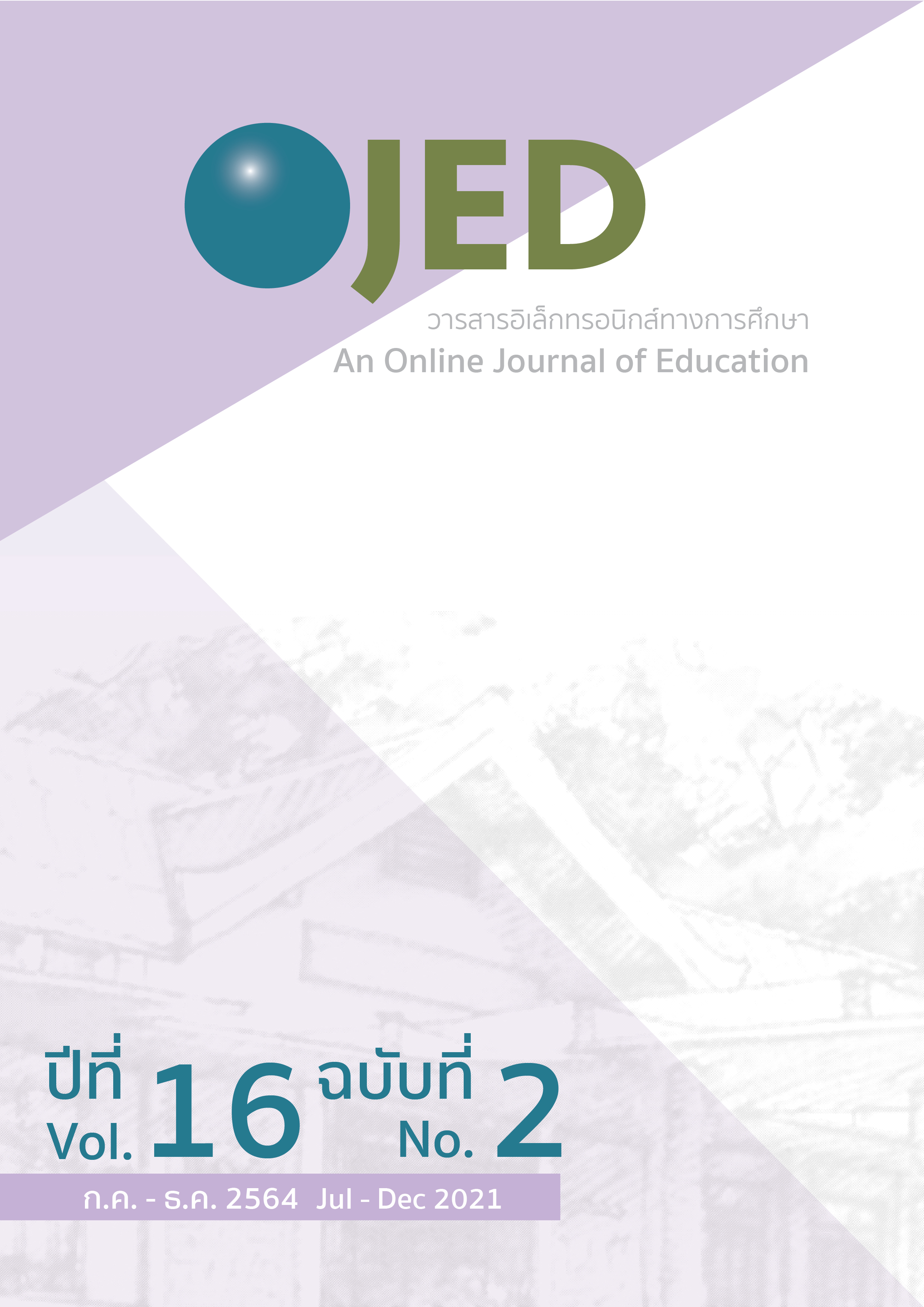ผลของการอ่านเชิงลึกโดยใช้เงื่อนไขของการเรียนรู้ต่อความรู้เรื่องคำศัพท์ของผู้เรียนภาษาอังกฤษเป็นภาษาต่างประเทศ
DOI:
https://doi.org/10.14456/ojed.2021.31คำสำคัญ:
ความรู้เรื่องคำศัพท์, การอ่านเชิงลึก, เงื่อนไขการเรียนรู้, การเรียนรู้คำศัพท์บทคัดย่อ
งานวิจัยนี้เป็นการทดลองแบบ single group pretest and posttest มีวัตถุประสงค์เพื่อ 1) ศึกษาการพัฒนาความรู้เรื่องคำศัพท์ของผู้เรียนภาษาอังกฤษเป็นภาษาต่างประเทศด้วยวิธีการอ่านเชิงลึกโดยใช้เงื่อนไขของการเรียนรู้คำศัพท์ 2) สำรวจความคิดเห็นของนักเรียนที่มีต่อการเรียนรู้คำศัพท์ด้วยวิธีการอ่านเชิงลึกโดยใช้เงื่อนไขของการเรียนรู้คำศัพท์ กลุ่มตัวอย่างประกอบด้วยนักเรียนระดับชั้นประถมศึกษาปีที่ 6 จำนวน 30 คน จากแผนการเรียนปกติ ในปีการศึกษา 2563 โรงเรียนเอกชนแห่งหนึ่งในจังหวัดพระนครศรีอยุธยา เครื่องมือวิจัยประกอบด้วย 1) แบบทดสอบความรู้เรื่องคำศัพท์ก่อนและหลังเรียน 2) แบบสอบถาม และ 3) คำถามสัมภาษณ์เกี่ยวกับความคิดเห็นของนักเรียนต่อการเรียนรู้คำศัพท์ด้วยวิธีการอ่านเชิงลึกโดยใช้เงื่อนไขของการเรียนรู้คำศัพท์ สถิติที่ใช้ในการงานวิจัยคือ paired-sample t-test , ค่าเฉลี่ย, ส่วนเบี่ยงเบนมาตรฐานและการวิเคราะห์เนื้อหา ผลการวิจัยพบว่า 1) การอ่านเชิงลึกโดยใช้เงื่อนไขของการเรียนรู้คำศัพท์มีผลต่อการพัฒนาความรู้เรื่องคำศัพท์อย่างมีนัยสำคัญ 2) ผลจากแบบสอบถามและการสัมภาษณ์ พบว่า นักเรียนมีความคิดเห็นเชิงบวกต่อการเรียนรู้คำศัพท์ด้วยการอ่านเชิงลึกโดยใช้เงื่อนไขของการเรียนรู้
เอกสารอ้างอิง
Al Hosni, S. (2014). Speaking difficulties encountered by young EFL learners. International Journal on Studies in English Language and Literature (IJSELL), 2(6), 22-30.
Boonyarattanasoontorn, P. (2017). An investigation of thai students english language writing difficulties and their use of writing strategies. Journal of Advanced Research in Social Sciences and Humanities, 2(2), 111-118.
Chang, A. C., & Renandya, W. A. (2020). The effect of narrow reading on L2 learners’ perceptions. RELC journal, 51(2), 244-258.
Chawwang, N. (2008). An investigation of English reading problems of Thai 12th Grade Students in Nakhonratchasima Educational Regions 1,2,3 and 7. (Master thesis). Srinakharinwirot, Bangkok.
Cho, K.-S., & Krashen, S. D. (1994). Acquisition of vocabulary from the Sweet Valley Kids series: Adult ESL acquisition. Journal of Reading, 37(8), 662-667.
Fikria, A. (2018). AN Intergration: Narrow Reading To West’s General Service List for Vocabulary Acquisition For Middle Sschool Level. IJET (Indonesian Journal of English Teaching), 7(1), 12-23.
Gardner, D. (2004). Vocabulary input through extensive reading: A comparison of words found in children's narrative and expository reading materials. Applied Linguistics, 25(1), 1-37.
Joe, A. (1995). Text-based tasks and incidental vocabulary learning. Second Language Research, 11(2), 149-158.
Joe, A. (1998). What effects do text-based tasks promoting generation have on incidental vocabulary acquisition? Applied Linguistics, 19(3), 357-377.
Kang, E. Y. (2015). Promoting L2 vocabulary learning through narrow reading. RELC journal, 46(2), 165-179.
Kotchana, S., & Tongpoon-Patanasorn, A. (2015). EFL Learners’ Vocabulary Size: A Case in the Northeastern Region of Thailand. AJE, 1(1).
Krashen, S. D. (2004). The case for narrow reading. Language Magazine, 3(5), 17-19.
Laufer, B. (2003). Vocabulary acquisition in a second language: Do learners really acquire most vocabulary by reading? Some empirical evidence. Canadian Modern Language Review, 59(4), 567-587.
Laufer, B., & Hulstijn, J. (2001). Incidental vocabulary acquisition in a second language: The construct of task-induced involvement. Applied Linguistics, 22(1), 1-26.
Meara, P. (1996). The dimensions of lexical competence. Performance and competence in second language acquisition, 35, 33-55.
Min, H. T. (2008). EFL vocabulary acquisition and retention: Reading plus vocabulary enhancement activities and narrow reading. Language Learning, 58(1), 73-115.
Nation. (2013). Learning Vocabulary in Another Language: Cambridge University Press.
Newton, J. (2013). Incidental vocabulary learning in classroom communication tasks. Language teaching research, 17(2), 164-187.
Patanasorn, C., & Patanasorn, A. (2011). English vocabulary size of Grade 6 students [Press release]
Pickens, J. (2005). Attitudes and perceptions. Organizational behavior in health care, 4(7).
Rababah, G. (2002). Communication Problems Facing Arab Learners of English.
Renandya, W. A., Krashen, S., & Jacobs, G. M. (2018). The Potential of Series Books: How Narrow Reading Leads to Advanced L2 Proficiency. LEARN Journal: Language Education and Acquisition Research Network, 11(2), 148-154.
Richards, J. C. (2015). Key issues in language teaching. Cambridge: Cambridge University Press.
Richards, J. C., & Renandya, W. A. (2002). Methodology in language teaching: An anthology of current practice: Cambridge university press.
Rodgers, M., & Webb, S. (2011). Narrow viewing: The vocabulary in related television programs. TESOL Quarterly, 45(4), 689-717.
Schmitt, N. (2000). Vocabulary in language teaching. Cambridge Cambridge University Press
Schmitt, N. (2008). Instructed second language vocabulary learning. Language teaching research, 12(3), 329-363.
Schmitt, N., & Carter, R. (2000). The lexical advantages of narrow reading for second language learners. Tesol Journal, 9(1), 4-9.
Srisawat, C., & Poonpon, K. (2014). An Investigation of vocabulary size of Thai university students. Paper presented at the The 3rd International Conference “Language, Society, and Culture in Asian Contexts”(LSCAC 2014) on Asian Dynamics: Prospects and Challenge.
Thornbury, S. (2006). How to teach vocabulary: Pearson Education India.
Ur, P. (2012). Vocabulary activities. Cambridge Cambridge university.
Webb, S., & Nation, P. (2017). How vocabulary is learned: Oxford University Press.
Wesche, M., & Paribakht, T. S. (1996). Enhancing Vocabulary Acquisition through Reading: A Hierarchy of Text-Related Exercise Types. Canadian Modern Language Review, 52(2), 155-178.
Zahar, R., Cobb, T., & Spada, N. (2001). Acquiring vocabulary through reading: Effects of frequency and contextual richness. Canadian Modern Language Review, 57(4), 541-572.
ดาวน์โหลด
เผยแพร่แล้ว
รูปแบบการอ้างอิง
ฉบับ
ประเภทบทความ
สัญญาอนุญาต
ลิขสิทธิ์ (c) 2021 วารสารอิเล็กทรอนิกส์ทางการศึกษา

อนุญาตภายใต้เงื่อนไข Creative Commons Attribution-NonCommercial-NoDerivatives 4.0 International License.




